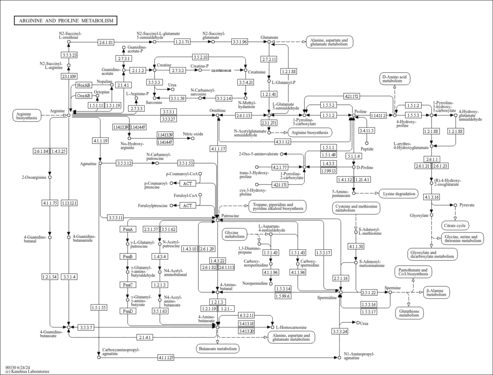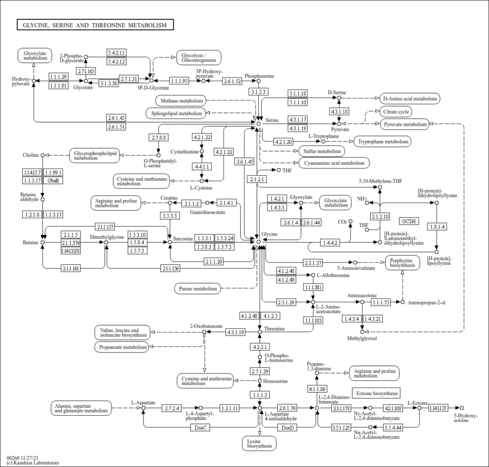| Guanidoacetic acid,1TMS,isomer #1 | C[Si](C)(C)OC(=O)CNC(=N)N | 1584.4 | Semi standard non polar | 33892256 |
| Guanidoacetic acid,1TMS,isomer #2 | C[Si](C)(C)NC(=N)NCC(=O)O | 1724.8 | Semi standard non polar | 33892256 |
| Guanidoacetic acid,1TMS,isomer #3 | C[Si](C)(C)N=C(N)NCC(=O)O | 1614.7 | Semi standard non polar | 33892256 |
| Guanidoacetic acid,1TMS,isomer #4 | C[Si](C)(C)N(CC(=O)O)C(=N)N | 1649.4 | Semi standard non polar | 33892256 |
| Guanidoacetic acid,2TMS,isomer #1 | C[Si](C)(C)NC(=N)NCC(=O)O[Si](C)(C)C | 1743.8 | Semi standard non polar | 33892256 |
| Guanidoacetic acid,2TMS,isomer #1 | C[Si](C)(C)NC(=N)NCC(=O)O[Si](C)(C)C | 1486.2 | Standard non polar | 33892256 |
| Guanidoacetic acid,2TMS,isomer #1 | C[Si](C)(C)NC(=N)NCC(=O)O[Si](C)(C)C | 2879.8 | Standard polar | 33892256 |
| Guanidoacetic acid,2TMS,isomer #2 | C[Si](C)(C)OC(=O)CN(C(=N)N)[Si](C)(C)C | 1642.1 | Semi standard non polar | 33892256 |
| Guanidoacetic acid,2TMS,isomer #2 | C[Si](C)(C)OC(=O)CN(C(=N)N)[Si](C)(C)C | 1469.1 | Standard non polar | 33892256 |
| Guanidoacetic acid,2TMS,isomer #2 | C[Si](C)(C)OC(=O)CN(C(=N)N)[Si](C)(C)C | 2770.8 | Standard polar | 33892256 |
| Guanidoacetic acid,2TMS,isomer #3 | C[Si](C)(C)N=C(N)NCC(=O)O[Si](C)(C)C | 1644.8 | Semi standard non polar | 33892256 |
| Guanidoacetic acid,2TMS,isomer #3 | C[Si](C)(C)N=C(N)NCC(=O)O[Si](C)(C)C | 1411.1 | Standard non polar | 33892256 |
| Guanidoacetic acid,2TMS,isomer #3 | C[Si](C)(C)N=C(N)NCC(=O)O[Si](C)(C)C | 2748.0 | Standard polar | 33892256 |
| Guanidoacetic acid,2TMS,isomer #4 | C[Si](C)(C)N(C(=N)NCC(=O)O)[Si](C)(C)C | 1833.0 | Semi standard non polar | 33892256 |
| Guanidoacetic acid,2TMS,isomer #4 | C[Si](C)(C)N(C(=N)NCC(=O)O)[Si](C)(C)C | 1541.6 | Standard non polar | 33892256 |
| Guanidoacetic acid,2TMS,isomer #4 | C[Si](C)(C)N(C(=N)NCC(=O)O)[Si](C)(C)C | 2821.7 | Standard polar | 33892256 |
| Guanidoacetic acid,2TMS,isomer #5 | C[Si](C)(C)N=C(NCC(=O)O)N[Si](C)(C)C | 1705.2 | Semi standard non polar | 33892256 |
| Guanidoacetic acid,2TMS,isomer #5 | C[Si](C)(C)N=C(NCC(=O)O)N[Si](C)(C)C | 1446.6 | Standard non polar | 33892256 |
| Guanidoacetic acid,2TMS,isomer #5 | C[Si](C)(C)N=C(NCC(=O)O)N[Si](C)(C)C | 2821.7 | Standard polar | 33892256 |
| Guanidoacetic acid,2TMS,isomer #6 | C[Si](C)(C)NC(=N)N(CC(=O)O)[Si](C)(C)C | 1748.5 | Semi standard non polar | 33892256 |
| Guanidoacetic acid,2TMS,isomer #6 | C[Si](C)(C)NC(=N)N(CC(=O)O)[Si](C)(C)C | 1520.6 | Standard non polar | 33892256 |
| Guanidoacetic acid,2TMS,isomer #6 | C[Si](C)(C)NC(=N)N(CC(=O)O)[Si](C)(C)C | 2683.8 | Standard polar | 33892256 |
| Guanidoacetic acid,2TMS,isomer #7 | C[Si](C)(C)N=C(N)N(CC(=O)O)[Si](C)(C)C | 1674.1 | Semi standard non polar | 33892256 |
| Guanidoacetic acid,2TMS,isomer #7 | C[Si](C)(C)N=C(N)N(CC(=O)O)[Si](C)(C)C | 1470.1 | Standard non polar | 33892256 |
| Guanidoacetic acid,2TMS,isomer #7 | C[Si](C)(C)N=C(N)N(CC(=O)O)[Si](C)(C)C | 2687.2 | Standard polar | 33892256 |
| Guanidoacetic acid,3TMS,isomer #1 | C[Si](C)(C)OC(=O)CNC(=N)N([Si](C)(C)C)[Si](C)(C)C | 1812.1 | Semi standard non polar | 33892256 |
| Guanidoacetic acid,3TMS,isomer #1 | C[Si](C)(C)OC(=O)CNC(=N)N([Si](C)(C)C)[Si](C)(C)C | 1610.7 | Standard non polar | 33892256 |
| Guanidoacetic acid,3TMS,isomer #1 | C[Si](C)(C)OC(=O)CNC(=N)N([Si](C)(C)C)[Si](C)(C)C | 2398.4 | Standard polar | 33892256 |
| Guanidoacetic acid,3TMS,isomer #2 | C[Si](C)(C)N=C(NCC(=O)O[Si](C)(C)C)N[Si](C)(C)C | 1728.2 | Semi standard non polar | 33892256 |
| Guanidoacetic acid,3TMS,isomer #2 | C[Si](C)(C)N=C(NCC(=O)O[Si](C)(C)C)N[Si](C)(C)C | 1404.3 | Standard non polar | 33892256 |
| Guanidoacetic acid,3TMS,isomer #2 | C[Si](C)(C)N=C(NCC(=O)O[Si](C)(C)C)N[Si](C)(C)C | 2554.3 | Standard polar | 33892256 |
| Guanidoacetic acid,3TMS,isomer #3 | C[Si](C)(C)NC(=N)N(CC(=O)O[Si](C)(C)C)[Si](C)(C)C | 1712.3 | Semi standard non polar | 33892256 |
| Guanidoacetic acid,3TMS,isomer #3 | C[Si](C)(C)NC(=N)N(CC(=O)O[Si](C)(C)C)[Si](C)(C)C | 1591.7 | Standard non polar | 33892256 |
| Guanidoacetic acid,3TMS,isomer #3 | C[Si](C)(C)NC(=N)N(CC(=O)O[Si](C)(C)C)[Si](C)(C)C | 2431.2 | Standard polar | 33892256 |
| Guanidoacetic acid,3TMS,isomer #4 | C[Si](C)(C)N=C(N)N(CC(=O)O[Si](C)(C)C)[Si](C)(C)C | 1641.8 | Semi standard non polar | 33892256 |
| Guanidoacetic acid,3TMS,isomer #4 | C[Si](C)(C)N=C(N)N(CC(=O)O[Si](C)(C)C)[Si](C)(C)C | 1458.6 | Standard non polar | 33892256 |
| Guanidoacetic acid,3TMS,isomer #4 | C[Si](C)(C)N=C(N)N(CC(=O)O[Si](C)(C)C)[Si](C)(C)C | 2599.0 | Standard polar | 33892256 |
| Guanidoacetic acid,3TMS,isomer #5 | C[Si](C)(C)N=C(NCC(=O)O)N([Si](C)(C)C)[Si](C)(C)C | 1776.6 | Semi standard non polar | 33892256 |
| Guanidoacetic acid,3TMS,isomer #5 | C[Si](C)(C)N=C(NCC(=O)O)N([Si](C)(C)C)[Si](C)(C)C | 1575.1 | Standard non polar | 33892256 |
| Guanidoacetic acid,3TMS,isomer #5 | C[Si](C)(C)N=C(NCC(=O)O)N([Si](C)(C)C)[Si](C)(C)C | 2452.9 | Standard polar | 33892256 |
| Guanidoacetic acid,3TMS,isomer #6 | C[Si](C)(C)N(CC(=O)O)C(=N)N([Si](C)(C)C)[Si](C)(C)C | 1780.5 | Semi standard non polar | 33892256 |
| Guanidoacetic acid,3TMS,isomer #6 | C[Si](C)(C)N(CC(=O)O)C(=N)N([Si](C)(C)C)[Si](C)(C)C | 1668.6 | Standard non polar | 33892256 |
| Guanidoacetic acid,3TMS,isomer #6 | C[Si](C)(C)N(CC(=O)O)C(=N)N([Si](C)(C)C)[Si](C)(C)C | 2365.2 | Standard polar | 33892256 |
| Guanidoacetic acid,3TMS,isomer #7 | C[Si](C)(C)N=C(N[Si](C)(C)C)N(CC(=O)O)[Si](C)(C)C | 1695.4 | Semi standard non polar | 33892256 |
| Guanidoacetic acid,3TMS,isomer #7 | C[Si](C)(C)N=C(N[Si](C)(C)C)N(CC(=O)O)[Si](C)(C)C | 1533.2 | Standard non polar | 33892256 |
| Guanidoacetic acid,3TMS,isomer #7 | C[Si](C)(C)N=C(N[Si](C)(C)C)N(CC(=O)O)[Si](C)(C)C | 2373.1 | Standard polar | 33892256 |
| Guanidoacetic acid,4TMS,isomer #1 | C[Si](C)(C)OC(=O)CN(C(=N)N([Si](C)(C)C)[Si](C)(C)C)[Si](C)(C)C | 1757.8 | Semi standard non polar | 33892256 |
| Guanidoacetic acid,4TMS,isomer #1 | C[Si](C)(C)OC(=O)CN(C(=N)N([Si](C)(C)C)[Si](C)(C)C)[Si](C)(C)C | 1737.2 | Standard non polar | 33892256 |
| Guanidoacetic acid,4TMS,isomer #1 | C[Si](C)(C)OC(=O)CN(C(=N)N([Si](C)(C)C)[Si](C)(C)C)[Si](C)(C)C | 2168.4 | Standard polar | 33892256 |
| Guanidoacetic acid,4TMS,isomer #2 | C[Si](C)(C)N=C(NCC(=O)O[Si](C)(C)C)N([Si](C)(C)C)[Si](C)(C)C | 1765.0 | Semi standard non polar | 33892256 |
| Guanidoacetic acid,4TMS,isomer #2 | C[Si](C)(C)N=C(NCC(=O)O[Si](C)(C)C)N([Si](C)(C)C)[Si](C)(C)C | 1561.2 | Standard non polar | 33892256 |
| Guanidoacetic acid,4TMS,isomer #2 | C[Si](C)(C)N=C(NCC(=O)O[Si](C)(C)C)N([Si](C)(C)C)[Si](C)(C)C | 2212.0 | Standard polar | 33892256 |
| Guanidoacetic acid,4TMS,isomer #3 | C[Si](C)(C)N=C(N[Si](C)(C)C)N(CC(=O)O[Si](C)(C)C)[Si](C)(C)C | 1715.8 | Semi standard non polar | 33892256 |
| Guanidoacetic acid,4TMS,isomer #3 | C[Si](C)(C)N=C(N[Si](C)(C)C)N(CC(=O)O[Si](C)(C)C)[Si](C)(C)C | 1525.0 | Standard non polar | 33892256 |
| Guanidoacetic acid,4TMS,isomer #3 | C[Si](C)(C)N=C(N[Si](C)(C)C)N(CC(=O)O[Si](C)(C)C)[Si](C)(C)C | 2180.4 | Standard polar | 33892256 |
| Guanidoacetic acid,4TMS,isomer #4 | C[Si](C)(C)N=C(N(CC(=O)O)[Si](C)(C)C)N([Si](C)(C)C)[Si](C)(C)C | 1792.2 | Semi standard non polar | 33892256 |
| Guanidoacetic acid,4TMS,isomer #4 | C[Si](C)(C)N=C(N(CC(=O)O)[Si](C)(C)C)N([Si](C)(C)C)[Si](C)(C)C | 1712.6 | Standard non polar | 33892256 |
| Guanidoacetic acid,4TMS,isomer #4 | C[Si](C)(C)N=C(N(CC(=O)O)[Si](C)(C)C)N([Si](C)(C)C)[Si](C)(C)C | 2011.1 | Standard polar | 33892256 |
| Guanidoacetic acid,5TMS,isomer #1 | C[Si](C)(C)N=C(N(CC(=O)O[Si](C)(C)C)[Si](C)(C)C)N([Si](C)(C)C)[Si](C)(C)C | 1809.1 | Semi standard non polar | 33892256 |
| Guanidoacetic acid,5TMS,isomer #1 | C[Si](C)(C)N=C(N(CC(=O)O[Si](C)(C)C)[Si](C)(C)C)N([Si](C)(C)C)[Si](C)(C)C | 1724.7 | Standard non polar | 33892256 |
| Guanidoacetic acid,5TMS,isomer #1 | C[Si](C)(C)N=C(N(CC(=O)O[Si](C)(C)C)[Si](C)(C)C)N([Si](C)(C)C)[Si](C)(C)C | 1848.3 | Standard polar | 33892256 |
| Guanidoacetic acid,1TBDMS,isomer #1 | CC(C)(C)[Si](C)(C)OC(=O)CNC(=N)N | 1835.5 | Semi standard non polar | 33892256 |
| Guanidoacetic acid,1TBDMS,isomer #2 | CC(C)(C)[Si](C)(C)NC(=N)NCC(=O)O | 1980.4 | Semi standard non polar | 33892256 |
| Guanidoacetic acid,1TBDMS,isomer #3 | CC(C)(C)[Si](C)(C)N=C(N)NCC(=O)O | 1859.7 | Semi standard non polar | 33892256 |
| Guanidoacetic acid,1TBDMS,isomer #4 | CC(C)(C)[Si](C)(C)N(CC(=O)O)C(=N)N | 1875.6 | Semi standard non polar | 33892256 |
| Guanidoacetic acid,2TBDMS,isomer #1 | CC(C)(C)[Si](C)(C)NC(=N)NCC(=O)O[Si](C)(C)C(C)(C)C | 2218.2 | Semi standard non polar | 33892256 |
| Guanidoacetic acid,2TBDMS,isomer #1 | CC(C)(C)[Si](C)(C)NC(=N)NCC(=O)O[Si](C)(C)C(C)(C)C | 1846.5 | Standard non polar | 33892256 |
| Guanidoacetic acid,2TBDMS,isomer #1 | CC(C)(C)[Si](C)(C)NC(=N)NCC(=O)O[Si](C)(C)C(C)(C)C | 2749.2 | Standard polar | 33892256 |
| Guanidoacetic acid,2TBDMS,isomer #2 | CC(C)(C)[Si](C)(C)OC(=O)CN(C(=N)N)[Si](C)(C)C(C)(C)C | 2079.4 | Semi standard non polar | 33892256 |
| Guanidoacetic acid,2TBDMS,isomer #2 | CC(C)(C)[Si](C)(C)OC(=O)CN(C(=N)N)[Si](C)(C)C(C)(C)C | 1865.8 | Standard non polar | 33892256 |
| Guanidoacetic acid,2TBDMS,isomer #2 | CC(C)(C)[Si](C)(C)OC(=O)CN(C(=N)N)[Si](C)(C)C(C)(C)C | 2822.9 | Standard polar | 33892256 |
| Guanidoacetic acid,2TBDMS,isomer #3 | CC(C)(C)[Si](C)(C)N=C(N)NCC(=O)O[Si](C)(C)C(C)(C)C | 2073.2 | Semi standard non polar | 33892256 |
| Guanidoacetic acid,2TBDMS,isomer #3 | CC(C)(C)[Si](C)(C)N=C(N)NCC(=O)O[Si](C)(C)C(C)(C)C | 1754.0 | Standard non polar | 33892256 |
| Guanidoacetic acid,2TBDMS,isomer #3 | CC(C)(C)[Si](C)(C)N=C(N)NCC(=O)O[Si](C)(C)C(C)(C)C | 2824.4 | Standard polar | 33892256 |
| Guanidoacetic acid,2TBDMS,isomer #4 | CC(C)(C)[Si](C)(C)N(C(=N)NCC(=O)O)[Si](C)(C)C(C)(C)C | 2234.0 | Semi standard non polar | 33892256 |
| Guanidoacetic acid,2TBDMS,isomer #4 | CC(C)(C)[Si](C)(C)N(C(=N)NCC(=O)O)[Si](C)(C)C(C)(C)C | 1930.3 | Standard non polar | 33892256 |
| Guanidoacetic acid,2TBDMS,isomer #4 | CC(C)(C)[Si](C)(C)N(C(=N)NCC(=O)O)[Si](C)(C)C(C)(C)C | 2636.5 | Standard polar | 33892256 |
| Guanidoacetic acid,2TBDMS,isomer #5 | CC(C)(C)[Si](C)(C)N=C(NCC(=O)O)N[Si](C)(C)C(C)(C)C | 2209.7 | Semi standard non polar | 33892256 |
| Guanidoacetic acid,2TBDMS,isomer #5 | CC(C)(C)[Si](C)(C)N=C(NCC(=O)O)N[Si](C)(C)C(C)(C)C | 1749.5 | Standard non polar | 33892256 |
| Guanidoacetic acid,2TBDMS,isomer #5 | CC(C)(C)[Si](C)(C)N=C(NCC(=O)O)N[Si](C)(C)C(C)(C)C | 2631.2 | Standard polar | 33892256 |
| Guanidoacetic acid,2TBDMS,isomer #6 | CC(C)(C)[Si](C)(C)NC(=N)N(CC(=O)O)[Si](C)(C)C(C)(C)C | 2204.0 | Semi standard non polar | 33892256 |
| Guanidoacetic acid,2TBDMS,isomer #6 | CC(C)(C)[Si](C)(C)NC(=N)N(CC(=O)O)[Si](C)(C)C(C)(C)C | 1922.2 | Standard non polar | 33892256 |
| Guanidoacetic acid,2TBDMS,isomer #6 | CC(C)(C)[Si](C)(C)NC(=N)N(CC(=O)O)[Si](C)(C)C(C)(C)C | 2599.3 | Standard polar | 33892256 |
| Guanidoacetic acid,2TBDMS,isomer #7 | CC(C)(C)[Si](C)(C)N=C(N)N(CC(=O)O)[Si](C)(C)C(C)(C)C | 2072.4 | Semi standard non polar | 33892256 |
| Guanidoacetic acid,2TBDMS,isomer #7 | CC(C)(C)[Si](C)(C)N=C(N)N(CC(=O)O)[Si](C)(C)C(C)(C)C | 1795.5 | Standard non polar | 33892256 |
| Guanidoacetic acid,2TBDMS,isomer #7 | CC(C)(C)[Si](C)(C)N=C(N)N(CC(=O)O)[Si](C)(C)C(C)(C)C | 2741.3 | Standard polar | 33892256 |
| Guanidoacetic acid,3TBDMS,isomer #1 | CC(C)(C)[Si](C)(C)OC(=O)CNC(=N)N([Si](C)(C)C(C)(C)C)[Si](C)(C)C(C)(C)C | 2399.0 | Semi standard non polar | 33892256 |
| Guanidoacetic acid,3TBDMS,isomer #1 | CC(C)(C)[Si](C)(C)OC(=O)CNC(=N)N([Si](C)(C)C(C)(C)C)[Si](C)(C)C(C)(C)C | 2197.7 | Standard non polar | 33892256 |
| Guanidoacetic acid,3TBDMS,isomer #1 | CC(C)(C)[Si](C)(C)OC(=O)CNC(=N)N([Si](C)(C)C(C)(C)C)[Si](C)(C)C(C)(C)C | 2533.7 | Standard polar | 33892256 |
| Guanidoacetic acid,3TBDMS,isomer #2 | CC(C)(C)[Si](C)(C)N=C(NCC(=O)O[Si](C)(C)C(C)(C)C)N[Si](C)(C)C(C)(C)C | 2335.8 | Semi standard non polar | 33892256 |
| Guanidoacetic acid,3TBDMS,isomer #2 | CC(C)(C)[Si](C)(C)N=C(NCC(=O)O[Si](C)(C)C(C)(C)C)N[Si](C)(C)C(C)(C)C | 1919.2 | Standard non polar | 33892256 |
| Guanidoacetic acid,3TBDMS,isomer #2 | CC(C)(C)[Si](C)(C)N=C(NCC(=O)O[Si](C)(C)C(C)(C)C)N[Si](C)(C)C(C)(C)C | 2562.8 | Standard polar | 33892256 |
| Guanidoacetic acid,3TBDMS,isomer #3 | CC(C)(C)[Si](C)(C)NC(=N)N(CC(=O)O[Si](C)(C)C(C)(C)C)[Si](C)(C)C(C)(C)C | 2375.4 | Semi standard non polar | 33892256 |
| Guanidoacetic acid,3TBDMS,isomer #3 | CC(C)(C)[Si](C)(C)NC(=N)N(CC(=O)O[Si](C)(C)C(C)(C)C)[Si](C)(C)C(C)(C)C | 2166.6 | Standard non polar | 33892256 |
| Guanidoacetic acid,3TBDMS,isomer #3 | CC(C)(C)[Si](C)(C)NC(=N)N(CC(=O)O[Si](C)(C)C(C)(C)C)[Si](C)(C)C(C)(C)C | 2556.0 | Standard polar | 33892256 |
| Guanidoacetic acid,3TBDMS,isomer #4 | CC(C)(C)[Si](C)(C)N=C(N)N(CC(=O)O[Si](C)(C)C(C)(C)C)[Si](C)(C)C(C)(C)C | 2259.8 | Semi standard non polar | 33892256 |
| Guanidoacetic acid,3TBDMS,isomer #4 | CC(C)(C)[Si](C)(C)N=C(N)N(CC(=O)O[Si](C)(C)C(C)(C)C)[Si](C)(C)C(C)(C)C | 2002.5 | Standard non polar | 33892256 |
| Guanidoacetic acid,3TBDMS,isomer #4 | CC(C)(C)[Si](C)(C)N=C(N)N(CC(=O)O[Si](C)(C)C(C)(C)C)[Si](C)(C)C(C)(C)C | 2786.2 | Standard polar | 33892256 |
| Guanidoacetic acid,3TBDMS,isomer #5 | CC(C)(C)[Si](C)(C)N=C(NCC(=O)O)N([Si](C)(C)C(C)(C)C)[Si](C)(C)C(C)(C)C | 2370.1 | Semi standard non polar | 33892256 |
| Guanidoacetic acid,3TBDMS,isomer #5 | CC(C)(C)[Si](C)(C)N=C(NCC(=O)O)N([Si](C)(C)C(C)(C)C)[Si](C)(C)C(C)(C)C | 2083.1 | Standard non polar | 33892256 |
| Guanidoacetic acid,3TBDMS,isomer #5 | CC(C)(C)[Si](C)(C)N=C(NCC(=O)O)N([Si](C)(C)C(C)(C)C)[Si](C)(C)C(C)(C)C | 2482.3 | Standard polar | 33892256 |
| Guanidoacetic acid,3TBDMS,isomer #6 | CC(C)(C)[Si](C)(C)N(CC(=O)O)C(=N)N([Si](C)(C)C(C)(C)C)[Si](C)(C)C(C)(C)C | 2384.2 | Semi standard non polar | 33892256 |
| Guanidoacetic acid,3TBDMS,isomer #6 | CC(C)(C)[Si](C)(C)N(CC(=O)O)C(=N)N([Si](C)(C)C(C)(C)C)[Si](C)(C)C(C)(C)C | 2272.8 | Standard non polar | 33892256 |
| Guanidoacetic acid,3TBDMS,isomer #6 | CC(C)(C)[Si](C)(C)N(CC(=O)O)C(=N)N([Si](C)(C)C(C)(C)C)[Si](C)(C)C(C)(C)C | 2497.0 | Standard polar | 33892256 |
| Guanidoacetic acid,3TBDMS,isomer #7 | CC(C)(C)[Si](C)(C)N=C(N[Si](C)(C)C(C)(C)C)N(CC(=O)O)[Si](C)(C)C(C)(C)C | 2322.9 | Semi standard non polar | 33892256 |
| Guanidoacetic acid,3TBDMS,isomer #7 | CC(C)(C)[Si](C)(C)N=C(N[Si](C)(C)C(C)(C)C)N(CC(=O)O)[Si](C)(C)C(C)(C)C | 2002.9 | Standard non polar | 33892256 |
| Guanidoacetic acid,3TBDMS,isomer #7 | CC(C)(C)[Si](C)(C)N=C(N[Si](C)(C)C(C)(C)C)N(CC(=O)O)[Si](C)(C)C(C)(C)C | 2457.3 | Standard polar | 33892256 |
| Guanidoacetic acid,4TBDMS,isomer #1 | CC(C)(C)[Si](C)(C)OC(=O)CN(C(=N)N([Si](C)(C)C(C)(C)C)[Si](C)(C)C(C)(C)C)[Si](C)(C)C(C)(C)C | 2590.4 | Semi standard non polar | 33892256 |
| Guanidoacetic acid,4TBDMS,isomer #1 | CC(C)(C)[Si](C)(C)OC(=O)CN(C(=N)N([Si](C)(C)C(C)(C)C)[Si](C)(C)C(C)(C)C)[Si](C)(C)C(C)(C)C | 2485.2 | Standard non polar | 33892256 |
| Guanidoacetic acid,4TBDMS,isomer #1 | CC(C)(C)[Si](C)(C)OC(=O)CN(C(=N)N([Si](C)(C)C(C)(C)C)[Si](C)(C)C(C)(C)C)[Si](C)(C)C(C)(C)C | 2487.6 | Standard polar | 33892256 |
| Guanidoacetic acid,4TBDMS,isomer #2 | CC(C)(C)[Si](C)(C)N=C(NCC(=O)O[Si](C)(C)C(C)(C)C)N([Si](C)(C)C(C)(C)C)[Si](C)(C)C(C)(C)C | 2564.0 | Semi standard non polar | 33892256 |
| Guanidoacetic acid,4TBDMS,isomer #2 | CC(C)(C)[Si](C)(C)N=C(NCC(=O)O[Si](C)(C)C(C)(C)C)N([Si](C)(C)C(C)(C)C)[Si](C)(C)C(C)(C)C | 2264.6 | Standard non polar | 33892256 |
| Guanidoacetic acid,4TBDMS,isomer #2 | CC(C)(C)[Si](C)(C)N=C(NCC(=O)O[Si](C)(C)C(C)(C)C)N([Si](C)(C)C(C)(C)C)[Si](C)(C)C(C)(C)C | 2466.5 | Standard polar | 33892256 |
| Guanidoacetic acid,4TBDMS,isomer #3 | CC(C)(C)[Si](C)(C)N=C(N[Si](C)(C)C(C)(C)C)N(CC(=O)O[Si](C)(C)C(C)(C)C)[Si](C)(C)C(C)(C)C | 2499.5 | Semi standard non polar | 33892256 |
| Guanidoacetic acid,4TBDMS,isomer #3 | CC(C)(C)[Si](C)(C)N=C(N[Si](C)(C)C(C)(C)C)N(CC(=O)O[Si](C)(C)C(C)(C)C)[Si](C)(C)C(C)(C)C | 2204.3 | Standard non polar | 33892256 |
| Guanidoacetic acid,4TBDMS,isomer #3 | CC(C)(C)[Si](C)(C)N=C(N[Si](C)(C)C(C)(C)C)N(CC(=O)O[Si](C)(C)C(C)(C)C)[Si](C)(C)C(C)(C)C | 2461.6 | Standard polar | 33892256 |
| Guanidoacetic acid,4TBDMS,isomer #4 | CC(C)(C)[Si](C)(C)N=C(N(CC(=O)O)[Si](C)(C)C(C)(C)C)N([Si](C)(C)C(C)(C)C)[Si](C)(C)C(C)(C)C | 2574.1 | Semi standard non polar | 33892256 |
| Guanidoacetic acid,4TBDMS,isomer #4 | CC(C)(C)[Si](C)(C)N=C(N(CC(=O)O)[Si](C)(C)C(C)(C)C)N([Si](C)(C)C(C)(C)C)[Si](C)(C)C(C)(C)C | 2383.4 | Standard non polar | 33892256 |
| Guanidoacetic acid,4TBDMS,isomer #4 | CC(C)(C)[Si](C)(C)N=C(N(CC(=O)O)[Si](C)(C)C(C)(C)C)N([Si](C)(C)C(C)(C)C)[Si](C)(C)C(C)(C)C | 2354.5 | Standard polar | 33892256 |
| Guanidoacetic acid,5TBDMS,isomer #1 | CC(C)(C)[Si](C)(C)N=C(N(CC(=O)O[Si](C)(C)C(C)(C)C)[Si](C)(C)C(C)(C)C)N([Si](C)(C)C(C)(C)C)[Si](C)(C)C(C)(C)C | 2797.0 | Semi standard non polar | 33892256 |
| Guanidoacetic acid,5TBDMS,isomer #1 | CC(C)(C)[Si](C)(C)N=C(N(CC(=O)O[Si](C)(C)C(C)(C)C)[Si](C)(C)C(C)(C)C)N([Si](C)(C)C(C)(C)C)[Si](C)(C)C(C)(C)C | 2593.3 | Standard non polar | 33892256 |
| Guanidoacetic acid,5TBDMS,isomer #1 | CC(C)(C)[Si](C)(C)N=C(N(CC(=O)O[Si](C)(C)C(C)(C)C)[Si](C)(C)C(C)(C)C)N([Si](C)(C)C(C)(C)C)[Si](C)(C)C(C)(C)C | 2350.8 | Standard polar | 33892256 |

